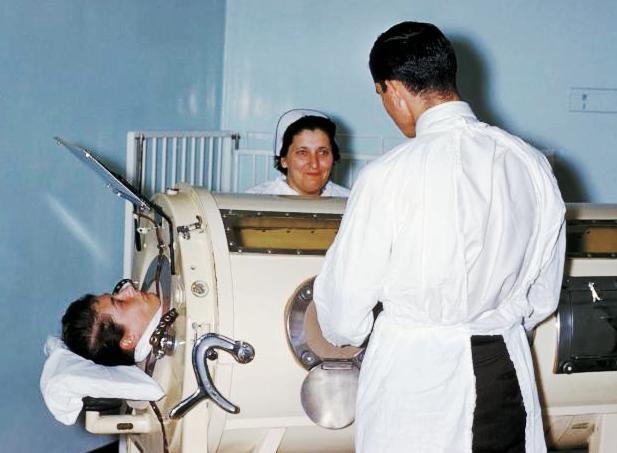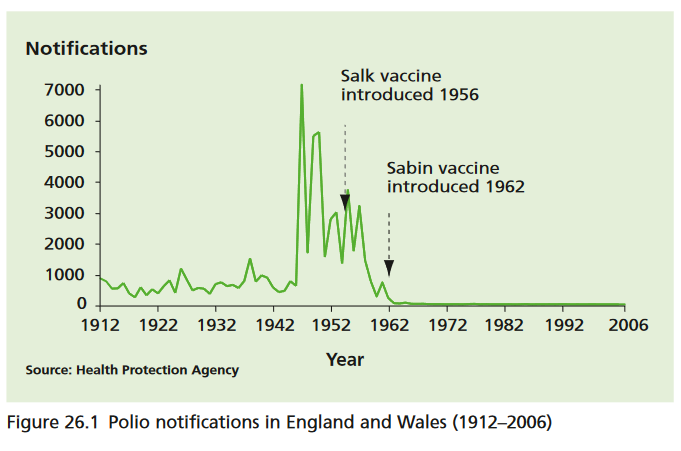If you’ve been looking at the news recently, you might have seen that there have been strains of polio found in samples taken at several London treatment works and the virus has been detected in 8 London boroughs[1]OnLondon: Why has polio been spreading in London in 2022?.
There have also been traces found in several US cities, along with some cases -at least one causing paralysis.
This is concerning as Polio can cause extreme illness in young children and those with weakened immune systems.
The UK has a robust vaccination program where all children receive a polio vaccine (I remember getting mine when I was about 5 or 6 on a sugar cube, a popular way to deliver it since the mass vaccination programme began in the UK back in the late 1950s and Early 1960s[2]Hull Live: Operation Sugar Cube – the mass vaccination programme in Hull that helped stamp out polio – and before you say anything, I am not that old thank you).
So let’s take a look at polio, what it is, when the UK last had to deal with it and why it’s making a comeback now.
What Is Polio?
Polio is a disease that can severely affect young children (usually under 5) and people with weakened immune systems.
It mainly spreads through faeces, which then if someone comes into contact with it and touch their mouth, the disease can enter the body.
Less likely methods of transmission are if an infected person’s faeces carries the disease into the water supply which, if not treated properly can cause it to spread to others. It can also spread through coughing and sneezing[3]NHS: Polio.
Polio is caused by the poliovirus which, once it gets into the body, replicates itself in the intestine where it then moves on into invading the nervous system[4]World Health Organisation: Poliomyelitis (polio).
The virus then disrupts the nervous system which can cause paralysis, this can be partial paralysis where the person still has some use of their motor functions and can get about, moving through different levels of severity where people are unable to even breath unaided or sadly die.
You might have heard of the term “Iron Lung” – these were machines that used to help polio patients breath after their lungs stopped functioning properly due to paralysis.

There are 3 strains of Polio, two of which are considered eradicated worldwide, type 2 was eradicated in 1999 and type 3 in 2022. Africa was declared type 1 polio free in 2020 but Type 1 is still widely present in Pakistan and Afghanistan mainly due to low take up rate of vaccination due to poor medical infrastructure, political unrest and religious reasons.
Also, after the COVID outbreak countries such as the UK are cutting payments to global vaccination programmes despite the threat of polio[5]The Guardian: It is vital to control diseases such as polio – so why is the UK cutting global vaccine funding? in these areas still.
What Are The Symptoms?
The incubation period ranges from three to 21 days so it won’t always be immediately obvious after you become infected.
Most people don’t exhibit any symptoms at all however, around 25% of people may experience “flu like” symptoms such as having a high temperature, feeling lethargic, muscle pain etc.
As a result, most people are putting this down to the flu (or COVID) and don’t even realise they could be spreading polio.
Don’t forget that even if transmission through coughs and sneezes isn’t common and the most direct method of infection is via the mouth, if you flush a toilet with the lid open the “toilet plume” can push germs and faecal matter all over your bathroom[6]Good Housekeeping: Please, for the Love of God, Close the Toilet Lid When You Flush[7]Microbiology Society: Does putting the lid down when flushing the toilet really make a difference? – including on to your toothbrush which helps the spread.
So if you feel a bit fluey, put the toilet seat down before you flush just in case.
How Is It Cured?
There isn’t a cure for polio, once you are infected with it all they can do is manage your symptoms and hope that they don’t get any worse.
The only way to stop polio is to ensure that you’re vaccinated. According to the World Health Organisation “More than 18 million people are able to walk today who would otherwise have been paralysed, since 1988, when the Global Polio Eradication Initiative was launched.[8]WHO: Poliomyelitis (polio)”.
Polio’s History
Polio has existed for millennia, with depictions of children walking with canes in ancient prehistoric Egyptian reliefs.
The disease itself wasn’t clinically described until 1789 and it wasn’t formally diagnosed as a disease until 1840.
There have been frequent outbreaks since it was diagnosed with one of the worst outbreaks being in the US in 1952 where over 3000 people died.
At this point in time, the disease seemed to be running rampant and over half-a-million people worldwide were dying every year. Those who didn’t die were left paralysed, unable to walk without assistance or had difficulty breathing which meant they spent most of their time in an iron long in order to be able to breathe[9]Wikipedia: Iron Lung
Vaccine development began in the 1930s but the methodology was rather unsound and didn’t follow standard procedures. The 1940s saw further development where the virus was able to be cultivated in a laboratory meaning testing of vaccines was simpler (and didn’t require a live human subject)[10]Wikipedia: Polio Vaccine.
It wasn’t until the 1952 where a workable vaccine that could be mass produced was developed. This was in part due to the mass outbreaks of polio that the US was seeing at the time, meaning that the programme had more funding than in previous years.
There were some quality control issues with this iteration of the vaccine causing some people to contract polio as the virus had not been made inactive, meaning that people had been injected with the live polio virus.
This lead to a Technical Committee being formed who would oversee the batches and test them to ensure they were safe to be used.
This also lead to the development of an oral vaccine (the one taken on a sugar cube) which would help avoid the issues seen with the previous injection method of delivery.
Past UK Polio Outbreaks
There have been several major outbreaks of Polio within the last 80 years in the UK. During the early 1950s, there were upwards of 8000 cases, with further spikes throughout the 1950s and into the early 1960s.
At this point, the success of the vaccination program started to become apparent and cases began to fall sharply.
The last major outbreak was in the 1970s with the last “in the wild” case coming in 1984.
Between 1985 and 2002, there were only 40 cases of polio recorded in the UK, of these 30 were due to an issue with the vaccine, 6 came from overseas and 5 were of unknown origin but there was no “wild” virus detected.

In 2003, the UK was declared Polio Free[11]The Telegraph: Polio is back: National incident declared in UK as disease spreads for first time in nearly 40 years by the World Health Organisation.
Why Is It Being Detected In The UK In 2022?
It appears that the version of the virus that’s being detected at the moment is a slightly mutated strain meaning that it has probably been spreading for a while which has allowed the virus to emerge into a new sub-strain.
As the virus has been technically eradicated for almost 20 years in the UK, it has probably been brought here by someone travelling from overseas as it would be unusual (if not impossible) for a wild strain to suddenly appear after such a long period of inactivity.
Because of the mutations, the vaccines given to children may be slightly less effective and as a result, the government are rolling out a vaccination booster program to those in the effected areas but we may see this move to a national program if the mutated version continues to spread.
How To Prevent Polio Spreading
With some people being asymptomatic (meaning you show no symptoms) or the symptoms being very similar to flu it may be difficult to tell if you or someone around you has it.
Make sure you wash your hands often and regularly. We shouldn’t have to say it but, as polio is spread through faeces, make sure to be extra diligent after going to the toilet and clean any surfaces down too (like taps), try not to share towels, and make sure you close the toilet seat because as we saw earlier…. Eeew!
Carry some hand sanitiser with you (yup, we’re back there again) and if you’re touching something like a trolley handle make sure you sterilise it and sanitise your hands before touching your eyes or mouth (déjà vu, right?)
Check your vaccination status and if you’re not sure ask your GP. In the US, they’re putting the quick spread down to a population that’s unvaccinated.
While it’s unlikely you can get polio via coughs or sneezes, if you’re going out and want to be on the safe side you might want to dig out of of those handy dandy masks you got during the pandemic.
But ultimately, the best way to stop the spread is to make sure everyone is vaccinated and people get their booster when offered so the virus has no where to go.




